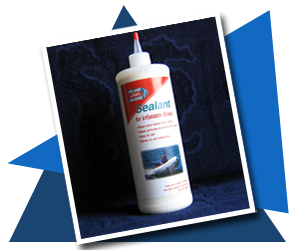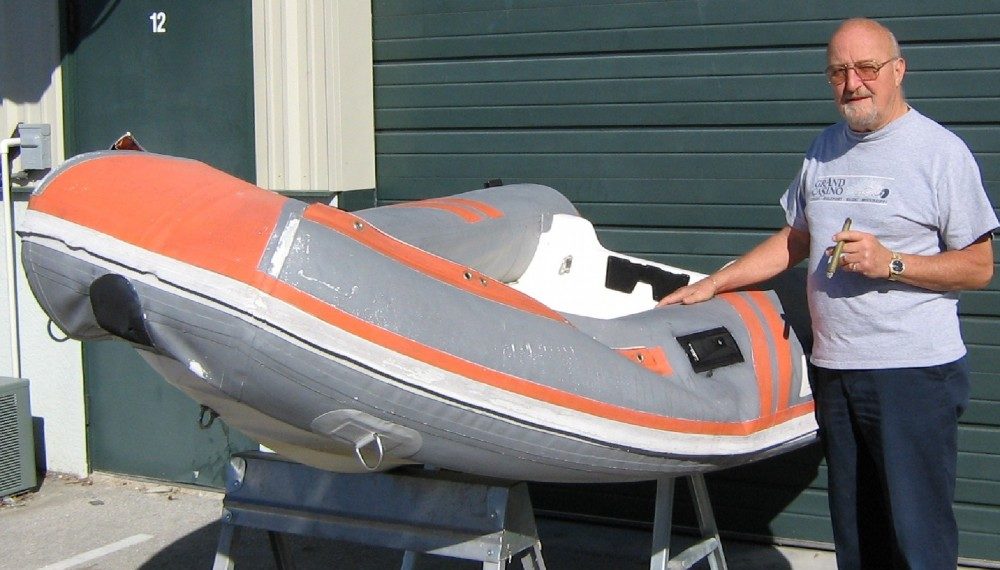How's YOUR Dinghy?
Inland Marine is anxious to help!
Calculating How Much Sealant to Use With Boats Over 12 Feet:
IMPORTANT!!
Be sure to check out our Getting Started information before beginning any inflatable repair project!

One quart of Inland Marine Sealant® is sufficient to seal small leaks on boats 12 feet long or smaller. On boats larger than 12 feet, there is a formula for calculating how much Sealant to use for each air chamber:
The basic rule is: 1/2 ounce of Sealant will cover 1 square foot of material.
The Formula for finding how many square feet of material there are inside your boat is: (Length of the Boat in feet) x 12 x 2 x (Diameter of the tube in inches) x 3.1416 -:- 576 = Number of ounces of Sealant needed to treat the boat.
This number, divided by the number of air chambers gives the amount of Sealant needed in each air chamber.
EXAMPLE:
A 15-foot boat with 22-inch tubes and three air chambers: 15 x 12 x 2 x 22 x 3.1416 = 24,881.47 square inches total area. 24,881.47 -:- 576 = 43.2 ounces of Sealant will be necessary to treat this boat. Divide 43.2 by 3 air chambers and each chamber will require about 14 ounces. It is recommended that you plan on two applications; use about 8 oz the first time and about 6 oz for the second treatment.
How-To:
There are a couple of options available to those who own inflatable boats too large or heavy for one person to tumble. One option is to call several friends and ask their help. (When choosing this option, always remember the Cardinal Rule of Boat Repair: When you’re out of beer, you’re out of friends.)
WITH FRIENDS:
- Deflate the boat and inject the Sealant in each air chamber as outlined in the standard instructions.
- Re-inflate the boat to rigidity.
- Have two friends on each end of the boat. (Now you’re management.)
- Raise the stern to about 45 degrees and hold for about 10 seconds.
- Lower the stern and raise the bow for 10 seconds.
- Turn the boat (rotate along its length) about five degrees and raise each end again.
- Continue rotating the boat 5 degrees at a time and lifting both ends until the boat has been turned completely over.
THE SECOND METHOD IS EASIER AND CAN BE ACCOMPLISHED WITH ONLY ONE PERSON!
(Your friends are now casual observers…they can furnish their own beer.)
- Place the boat to be treated flat on the ground.
- Deflate the boat and add the Sealant following the standard instructions.
- WITH THE BOAT STILL DEFLATED, walk the Sealant around the air chamber, that is, step on the air chamber while it is deflated pressing the top half of the air chamber firmly onto the bottom half.
- Start at the valves and work your way to the ends until you are sure all the top half of the chamber has contacted the bottom half. (Another alternative to walking the boat is to use a garden type roller to help spread the Sealant.)
- When you are sure Sealant has made contact with the entire interior of the air chamber, walk it again!
- Now you’re ready to re-inflate the boat to RIGIDITY.
- Wait 3 hours, then inflate the boat to full pressure and check for leaks.
- In the unlikely event that there are still leaks, re-treat the boat using only 1/3 the amount used the first time. Make sure the Sealant gets to the leaking area. Do not allow the Sealant to pool in any one area.
MORE IS NOT BETTER!
Tip from Customer Michael M in Portland, OR
I have an 18-foot Avon with 70 hp motor. Regular sealant instructions wouldn’t work. However, I finally hit upon the perfect solution. I opened the fill valve seat in the boat by pushing and turning ¼ turn the valve stem. I then hooked the fill hose to a scuba tank high pressure direct and then near the end of the hose where it enters the Avon fill valve I put a small hole in the hose and injected sealant into the hose at the same time as I filled the tube rapidly with high pressure air from the scuba tank. It atomized the sealant and filled the tube with the air/sealant mixture. When I removed the fill hose the atomized sealant came out of the tube as a white (sticky) fog. I waited about 20 minutes with the tube inflated and then deflated it. The particles of sealant had settled over the inside of the tube as there was no fog. I redid the same procedure one more time using about 2 fluid oz. each time. I then left it inflated and tested it with water in about 10 minutes and all the leaks had stopped over the entire length of the 6 foot tube. (See video below). I will be able to do the entire boat with about 16 fluid oz. Hope this information helps someone else.
Cheers, MM
Still Have Questions?
We welcome your questions at Inland Marine and would be happy to help you in choosing the right product for your restoration project. Just let us know!







